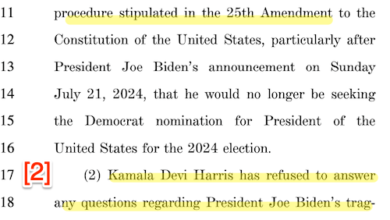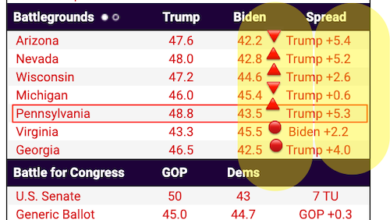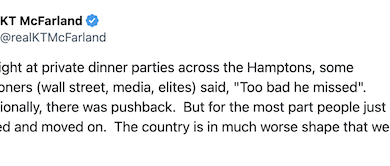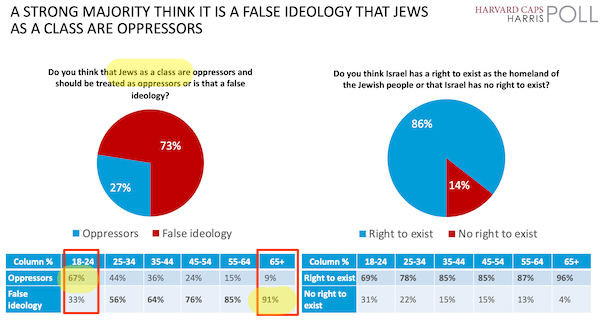
By Lambert Strether of Corrente.
Today I propose to venture for starters into child psychology before returning to the firmer swamps of philosophy and politics. (I am sure, this being the Naked Capitalism commentariat, that we have subject matter experts in all these fields, and I invite you to correct me when I stray, which will be often.) So let me begin with a question:
When and how do babies learn nouns?
There is a vast literature, from which I have selected the following to suit my tendentious purposes. It reflects, at least from my reading, the conventional wisdom. From Harvard’s Babies and Language:
Did you know that babies around the world usually have first words that are similar to each other? Many babies start talking with “mama” or “doggy,” but you would be surprised to hear a baby’s first word was “cartwheel” or “the!” Have you ever wondered why so many babies, who grow up to be very different people, start with the same few words?
Research has uncovered 3 features that make a good first word. Most first words have the following three properties:
- They are nouns
- They have easy sounds to make
- Kids hear them often
Let’s break down why each of these features matter.
(One of the gratifying aspects of this work from Harvard is that it’s written in the academic equivalent of baby talk.) Let’s focus on the first item:
The first feature that matters is word class, or the grammatical category that words fall into. Across almost all of the world’s languages, greetings and nouns enter babies’ productive vocabularies first.
Skipping greetings to get to the nouns:
To talk about the world, babies need content words (like nouns, verbs, and adjectives) and function words (like prepositions and pronouns). Judith Goodman and her colleagues showed that
This is that are often in babies’ environments. Babies can put toys in their mouths, cuddle with blankets, or throw a bottle off their high chair tray, giving them lots of sensory information about the objects.
Babies have fewer ways to explore the meanings of common verbs, since they can’t do most actions yet. Furthermore, lots of verbs refer to actions that only happen for an instant, like “hop,” or aren’t visible, like “think.” Function words are even harder to learn since “of” and “the” don’t point to anything in the physical world.
Because of their easy-to-explore nature, most babies start talking with concrete nouns. This trend holds across languages, whether babies hear French, Hebrew, or Korean.
(It’s fair to point out that some disagree[1].) It is true that objects are stable — whether at the perceptual or conceptual level — or so at least one hopes, but how does a baby categorize the objects it encounters? Why is this orange an “orange,” just like that orange? From Developmental Psychology, “The Development Of Object Categorization In Young Children: Hierarchical Inclusiveness, Age, Perceptual Attribute, And Group Versus Individual Analyses“:
Multiple levels of category inclusiveness in 4 object domains (animals, vehicles, fruit, and furniture) were examined using a sequential touching procedure and assessed in both individual and group analyses in 80 12-, 18-, 24-, and 30-month-olds…. Categories are especially valuable in infancy and early childhood when many new objects, events, and people are encountered because, without the ability and proclivity to categorize, children would have to learn to respond anew to each novel entity they experience.”
But from the conclusion:
(Oakes et al., 1997, p. 396). An understanding of categorization is also evidenced by the ability to form categories at different levels of abstraction. A logical and informative goal of research on children’s categorization is to focus on process and identify the conditions under which children do and do not categorize one way or another (e.g., Blewitt, 1989, 1994; Greco, Hayne, & Rovee-Collier, 1990; Oakes & Madole, 2000). However, the world of categories also consists of universal, structural taxonomies, and understanding which categorical representations children of different ages acknowledge or possess is equally valuable to understanding mental development in childhood or a process orientation (Neisser, 1987)
Moving on from babies to children[2], to Cognitive Science, “Child categorization“:
We argue for a composite perspective in which categories are from a young age but also are informed by low-level similarity and associative learning cues.
Interestingly, nouns, based on these “commonsense theories” and “ad hoc” “categorizations” are stored — to descend to a metaphor from IT — in different parts of the brain from verbs (and we’ll make the heroic assumption that this is true for babies, children, and on up, if “up” is the word I want). From an enormous metastudy in Human Brain Mapping, “Neural representation of word categories is distinct in the temporal lobe: An activation likelihood analysis“:
The purpose of this study is to elucidate the neurocognitive architecture of language by determining if the processing of nouns and verbs yields distinct or overlapping neural activation. Uncovering the neural architecture of nouns and verbs is crucial in resolving the debate of whether grammatical class is a fundamental organizing principle of mental lexicon, and if this entails distinct neural architecture for each grammatical category. The purpose of this study is to elucidate the neurocognitive architecture of language by determining if the processing of nouns and verbs yields distinct or overlapping neural activation.
A single cluster was uniquely associated with nouns in the direct analysis (NvsV) and was located in the bordering on the parahippocampal gyrus (BA37).
From Neuroimage, “Neural differences in the mapping of verb and noun concepts onto novel words“:
A dissociation between noun and verb processing has been found in brain damaged patients leading to the proposal that different word classes are supported by different neural representations. This notion is supported by the facts that children acquire nouns faster and adults usually perform better for nouns than verbs in a range of tasks. In the present study, we simulated word learning in a variant of the human simulation paradigm that provided only linguistic context information and required young healthy adults to map noun or verb meanings to novel words. The mapping of a meaning associated with a new-noun and a new-verb recruited different brain regions as revealed by functional magnetic resonance imaging. While , larger activation was observed for new-verbs in the left posterior middle temporal gyrus and left inferior frontal gyrus (opercular part)
And a press release, “Nouns and verbs are learned in different parts of the brain“:
Two Spanish psychologists and a German neurologist have recently shown that the brain that activates when a person learns a new noun is different from the part used when a verb is learnt. The scientists observed this using brain images taken using functional magnetic resonance, according to an article they have published this month in the journal Neuroimage.
“ while learning verbs switches on other regions (the left inferior frontal gyrus and part of the left posterior medial temporal gyrus)”, Antoni Rodríguez-Fornells, co-author of the study and an ICREA researcher at the Cognition and Brain Plasticity Unit of the University of Barcelona, tells SINC.
What else, you ask, does the left fusiform gyrus do? From (sorry) Wikipedia:
Though the functionality of the fusiform gyrus is not fully understood, it has been linked with various neural pathways related to recognition…. The term fusiform gyrus (lit. “spindle-shaped convolution”) refers to the fact that the shape of the gyrus is wider at its centre than at its ends…. The exact functionality of the fusiform gyrus is still disputed, but there is relative consensus on its involvement in the following pathways… Further research by MIT scientists showed that the left and right fusiform gyri played different roles, which subsequently interlinked. that may or may not be actual faces, whereas the right fusiform gyrus determines if that recognized face-like feature is, in fact, a face.
From Brain, “What the left and right anterior fusiform gyri tell us about semantic memory“:
Significant correlations (P < 0.05) were found between the left fusiform gyrus and both picture naming and category fluency tests (respectively, R = 0.619 and 0.584).
All this brain genius stuff allows me to pivot away from both nouns (categorization) and neuro-anatomy (embodiment) to philosophy. Here is Wittgenstein on categories and classification systems. From Philosophical Investigations, quoting a great slab (ha ha) of paragraphs 65–67:
65. … Instead of producing something common to all that we call language, I am saying that these phenomena have no one thing in common which makes us use the same word for all,— but that they are related to one another in many different ways. And it is because of this relationship, or these relationships, that we call them all “language”. I will try to explain this.
66. Consider for example the proceedings that we call “games”. I mean board-games, card-games, ball-games, Olympic games, and so on. What is common to them all?—Don’t say: “There must be something common, or they would not be called ‘games’ “—but look and see whether there is anything common to all.—For if you look at them you will not see something that is common to all, but similarities, relationships, and a whole series of them at that. To repeat: [3]—Look for example at board-games, with their multifarious relationships. Now pass to card-games; here you find many correspondences with the first group, but many common features drop out, and others appear. When we pass next to ballgames, much that is common is retained, but much is lost.—Are they all ‘amusing’? Compare chess with noughts and crosses. Or is there always winning and losing, or competition between players? Think of patience. In ball games there is winning and losing; but when a child throws his ball at the wall and catches it again, this feature has disappeared. Look at the parts played by skill and luck; and at the difference between skill in chess and skill in tennis. Think now of games like ring-a-ring-a-roses; here is the element of amusement, but how many other characteristic features have disappeared! And we can go through the many, many other groups of games in the same way; can see how similarities crop up and disappear. And the result of this examination is: we see a complicated network of similarities overlapping and criss-crossing: sometimes overall similarities, sometimes similarities of detail.
67.
In other words, at least for features and color of eyes, the sort of thing that’s recognized by the fusiform gyrus (not to be a vulgar materialists, I’m really not).
— And I shall say: ‘games’ form a family.
And for instance the kinds of number form a family in the same way. Why do we call something a “number”? Well, perhaps because it has a—direct—relationship with several things that have hitherto been called number; and this can be said to give it an indirect relationship to other things we call the same name. And we extend our concept of number as in spinning a thread we twist fibre on fibre. And the strength of the thread does not reside in the fact that some one fibre runs through its whole length, but in the overlapping of many fibres.
But if someone wished to say: “There is something common to all these constructions—namely the disjunction of all their common properties”—I should reply: Now you are only playing with words. One might as well say: “Something runs through the whole thread— namely the continuous overlapping of those fibres”.
I submit that the “commonsense theories” and “ad hoc” “categorizations” of child psychologists, and the “category fluency” and the “may or may not be actual faces” of neuro-anatomists, are describing the phenomenon that Wittgenstein named: Family resemblance. Like adaption, categorization is a mishegoss of spandrels.
After this Luis Tiant-like windup, let us turn to a contemporary example of categorization. Here is a handy chart from the Harvard CAPS Harris poll, field dates December 13-14, 2023:

No doubt there will be a good deal of pearl-clutching about the differential between the 18-24s and the 65+s (could it be that a successful identification of “the Jews” with Zionism is a problem, here?). However, I would like to focus on the unexamined categorization of “Jews as a class.” What can it mean? How does the classification take place? What is it based on? Does a baby, a child, or an adult do the classification, and how is it done? Is the categorization one of “family resemblance”? Or is the categorization more a formal taxonomy — a racial hierarchy, say? (Do note that all forms of identity politics face the same categorization issue[4]; see Adolph Reed here.) If all Jews either are or are not oppressors, how is that determination made? (Perhaps the poll is a merely a Keynesian beauty contest, with the answers determined by whatever factions are hegemonic within the age cohorts questioned?).
Perhaps the determination is made by magic (a process in which hegemony is often disguised). From the terrific TV Tropes:
When people go around using magic at random in fiction, certain laws are employed to explain how such magic works.
The Law of Names: Related to both the Law of Knowledge and the Law of Association. The law simply states that by knowing the true and complete name of a phenomenon or entity gives you complete control over it (This law is responsible for things like I Know Your True Name).
As in LeGuin’s wonderful Wizard of Earthsea trilogy. More to the point:
Law of Synecdoche (from the Lord Darcy series) “the part is equivalent to the whole”. An example would be using someone’s hair to cast a spell on them. Often seen as a sub-part of the Law of Contagion.
I’m trying, here, to come up with a response to “Jews as a class” a little bit more supple than #NotAllJews (even though that’s obviously the case). Here is the definition of “Jew” from my Oxford English Dictionary app:
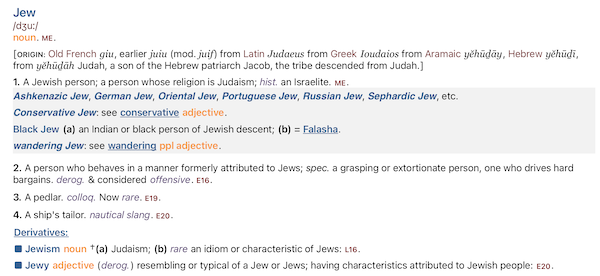
Rich fodder for classification struggles in the Derivatives section! But I think even sense 1 is contested. Are anti-Zionist Jews “real Jews”? I would say, then, with Wittgenstein, that the Harvard Harris categorization — and I think this goes for all identities as defined by identity politics — is not a formal system like, say, the periodic table, but a lot more like Wittgenstein’s “overlapping of many fibres,” since here we have at least two fibres: Those who assert that Zionism is Judaism, and those who do not; and we probably have more fibres than that; it’s a complex world. What is going on, I think, with phrases like “Jews as a class,” is a form of synecdoche, where a subset of a class is taken as a proxy for the entire class.
Wikipedia (again, sorry) defines synecdoche — pronounced, as I was today years old when I learned, suh·nek·duh·kee, rather like Schenectady — as follows:
Synecdoche (/sɪˈnɛkdəki/ sih-NEK-də-kee)[1] is a type of metonymy; it is a figure of speech in which a term for a part of something is used to refer to the whole (pars pro toto), or vice versa (totum pro parte). The term is derived from Ancient Greek συνεκδοχή (sunekdokhḗ) ‘simultaneous understanding’
Common English synecdoches include suits for businessmen, wheels for automobile, and boots for soldiers.
The trick here, the magic, if you will — the ladder that the noun pulls up after itself as it disappears into “having classified” from “classifying” — is that in this particular form of synecdoche, the part and the whole are represented (“simultaneous understanding”) by the same noun. The whole is the entire class (“Jews as a class”). The part is the “commonsense theories” and “ad hoc” “categorizations” — family resemblances — that identify the members of the class through which the categorization is performed. Sadly — and as opposed to “suit” for “businessperson” — the same noun is used for both part and whole. And you can bet that all those surveyed by the Harvard Harris poll are have different versions of “common sense.”
The moral of the story: It’s not worth killing people people over nouns. Realpolitik? Possibly. So-called class warfare, where the class and class responsibilities can be very clearly delineated? Again, possibly. But let’s move the discussion to that level. Not nouns!
NOTES
[1] In Scientific American, we see the argument that “Nouns first” is not universal, but cultural:Twila Tardif, a linguist at the University of Michigan, remembers the day she and her Mandarin-speaking babysitter watched as Tardif’s 11-month-old daughter crawled over to a pen that had just fallen on the floor and pointed to it. “Pen!” Tardif told her daughter in Mandarin just as her sitter said, “Grab!” also in Mandarin. Then they looked at each other in puzzlement. Tardif realized that caregivers in different cultures might be influencing which words babies learn first.
Augustine (quoted in Wittgenstein’s Philosophical Investigations, footnote 1) seems to take a “functions first” approach:
[2] Of course, categorization is a life-long activity. From one of my favorite Rex Stout novels, Over My Dead Body:When they (my elders) named some object, and accordingly moved towards something, I saw this and I grasped that the thing was called by the sound they uttered when they meant to point it out. Their intention was shewn by their bodily movements, as it were the natural language of all peoples: the expression of the face, the play of the eyes, the movement of other parts of the body, and the tone of voice which expresses our state of mind in seeking, having, rejecting, or avoiding something. Thus, as I heard words repeatedly used in their proper places in various sentences, I gradually learnt to understand what objects they signified; and after I had trained my mouth to form these signs, I used them to express my own desires.
[3] The Stanford Encyclopedia of Philosophy has this to say about Wittgenstein’s injunction:“My son,” he said in a tone of civilized exasperation, “is a little bit green. It’s unavoidable that youth should arrange people in categories, it’s the only way of handling the mass of material at first to avoid hopeless confusion, but the sorting out should not be too long delayed. My son seems to be pretty slow at it. He overrates some people and underrates others. Perhaps I’ve tried to rush it by opening too many doors for him. A father’s conceit can be a very disastrous thing.”
He tapped ashes from his cigarette. He asked abruptly but not at all pugnaciously, “What is it you want, Mr Wolfe?”
[Philosophy of Psychology – A Fragment” (PPF)] is the locus classicus of a key Wittgensteinian term – “seeing aspects” (PPF xi), where “two uses of the word ‘see’” are elaborated. The second use, where one “sees” a likeness in two objects, is the one that has given rise to the question of aspect perception and the attendant phenomena of aspect-dawning and change of aspect. (113). Aspect seeing involves noticing something about an object – an aspect of the object – that one hadn’t noticed before and thereby seeing it as something different. Importantly, it also arises as a result of a change of context of our perceptions. This immensely insightful discovery by Wittgenstein, and its successive development, has been the source of a multitude of discussions dealing with questions of objectivity vs. subjectivity, conception vs. perception, and psychology vs. epistemology. It also highlights the move from dogmatic, formalistic universalism to open, humanistic context-laden behavior, aptly reverberating in the to-and-fro of seeing aspects.[4] I would say “category error” (“green ideas”) here, except that categorization is more contested than I thought, so I have to think about it.
Source link

